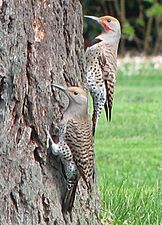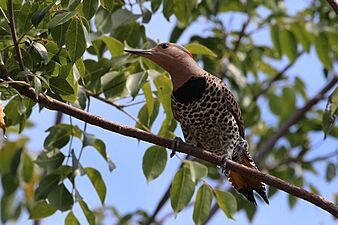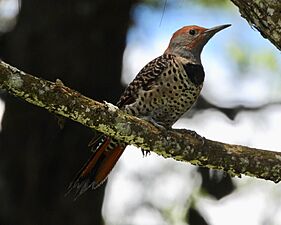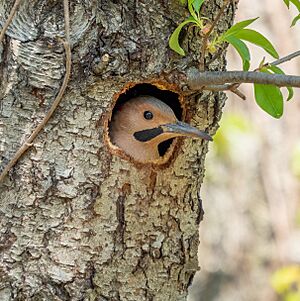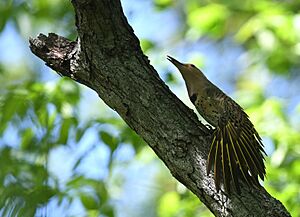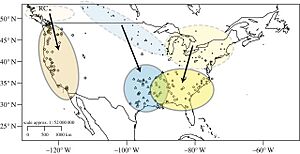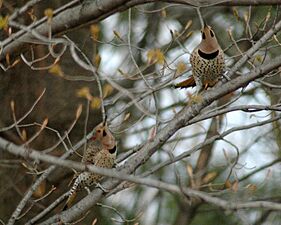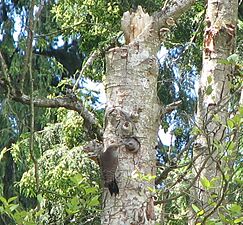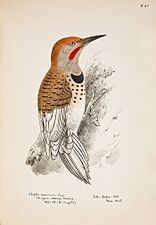Northern flicker facts for kids
Quick facts for kids Northern flicker |
|
|---|---|
 |
|
| Female C. a. auratus | |
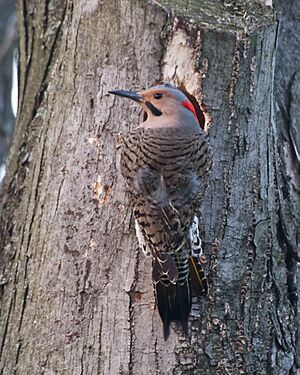 |
|
| Male C. a. auratus | |
| Conservation status | |
| Scientific classification | |
| Genus: |
Colaptes
|
| Species: |
auratus
|
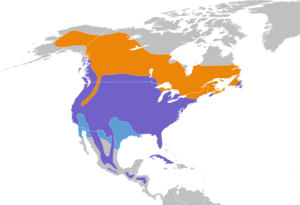 |
|
| Approximate distribution map
Breeding Year-round Nonbreeding |
|
| Synonyms | |
|
|
The northern flicker (Colaptes auratus) is a medium-sized bird. It belongs to the woodpecker family. You can find it in most of North America, parts of Central America, Cuba, and the Cayman Islands. It is one of the few woodpeckers that migrates.
Many people know the northern flicker by over 100 different names. Some common names include yellowhammer, clape, and heigh-ho. Many of these names sound like the bird's calls. The northern flicker is the state bird of Alabama. There, it is often called the "yellowhammer."
Contents
Understanding Northern Flicker Types
Scientists group living things into categories. This helps us understand how they are related. The northern flicker was first described by Mark Catesby in the 1700s. Later, in 1758, a Swedish scientist named Carl Linnaeus gave it the scientific name Cuculus auratus. The word auratus means "gilded" or "decorated with gold." This refers to the bird's golden feathers.
Different Kinds of Northern Flickers
There are ten known types, or subspecies, of the northern flicker. One of these is now extinct. These different types used to be seen as two separate species. They were called the yellow-shafted flicker and the red-shafted flicker. However, they often breed together where their homes overlap. Because of this, scientists now consider them all one species.
Yellow-shafted Group
- The southern yellow-shafted flicker (C. a. auratus) lives in the southeastern United States. It has yellow under its tail and wings. Its wing feathers also have yellow shafts. It has a gray cap and a beige face. Males have a black stripe near their beak, like a mustache. This bird is the state bird of Alabama. It is known as the "yellowhammer." This name came from the American Civil War. It described Confederate soldiers from Alabama.
- The northern yellow-shafted flicker (C. a. luteus) lives from central Alaska across Canada to the northeastern United States.
- The Cuban yellow-shafted flicker (C. a. chrysocaulosus) lives only in Cuba.
- The Grand Cayman yellow-shafted flicker (C. a. gundlachi) lives only on Grand Cayman Island.
Red-shafted Group
- The western red-shafted flicker (C. a. cafer) lives in western North America. It has red under its tail and wings. Its wing feathers have red shafts. It has a beige cap and a gray face. Males have a red mustache-like stripe. The scientific name cafer has a difficult history. It came from a mistake made long ago. Some people find this name offensive. There have been talks about changing it.
- The coastal red-shafted flicker (C. a. collaris) lives along the West Coast of North America. Its home is similar to C. a. cafer.
- The dwarf red-shafted flicker (C. a. nanus) lives in western Texas and northeastern Mexico.
- The Mexican red-shafted flicker (C. a. mexicanus) lives in central and southern Mexico.
- The Guatemalan red-shafted flicker (C. a. mexicanoides) lives in the mountains of southern Mexico and Central America. Some scientists think it might be its own species.
- The Guadalupe red-shafted flicker (C. a. rufipileus) is extinct. It used to live only on Guadalupe Island off Mexico. The last one was seen in 1906.
Physical Description
Adult northern flickers are brown with black stripes on their back and wings. They are a medium to large-sized bird. They are about 11 to 14 inches (28 to 36 cm) long. Their wingspan is about 16.5 to 21 inches (42 to 54 cm). They can weigh from 3 to 6 ounces (86 to 167 g).
They have a black patch on their upper chest. Their lower chest and belly are beige with black spots. Male flickers have a black or red stripe near their beak. This stripe looks like a mustache. Females do not have this stripe. Their tail is dark on top. It turns white near their body, which you can see when they fly.
Calls and Flight
The northern flicker makes a loud, laughing call. It sounds like "ki ki ki ki." This is different from other woodpeckers. They also make a constant knocking sound. They drum on trees or even metal objects. This helps them mark their territory. They want to make the loudest noise possible.
Like many woodpeckers, their flight is wavy. They flap their wings quickly, then pause. This creates a roller coaster-like motion.
What Northern Flickers Eat
Northern flickers are special among woodpeckers. They often look for food on the ground. They use their beak to probe the soil. They also catch insects while flying. Their main food is insects. Ants can make up almost half of what they eat. They also eat flies, butterflies, beetles, and snails.
In winter, they eat berries and seeds. These include berries from poison ivy and sumac. They also eat sunflower and thistle seeds. Northern flickers sometimes dig into underground ant nests. They want to get the tasty larvae inside. They might even break apart cow dung to find insects. Their tongues are very long. They can stick out about 2 inches (50 mm) to catch prey.
Northern flickers help control pests. They eat the European corn borer. This moth causes a lot of damage to corn crops. Flickers also do something called anting. They use ants to help clean their feathers. The acid from the ants helps keep them free of tiny pests.
Where Northern Flickers Live
You can see northern flickers in open areas with trees. This includes woodlands, yards, and parks. In the western United States, they live in mountain forests. They can be found all the way up to the tree line.
Northern flickers usually make their nests in holes in trees. Both the male and female help dig the nest hole. The entrance hole is about 3 inches (8 cm) wide. The nest cavity is about 13 to 16 inches (33 to 41 cm) deep. The bottom of the cavity is wider. This gives space for the eggs and the parent bird. Inside, there are only wood chips for the eggs and chicks. When the chicks are older, they cling to the wall. They do not lie on the floor. Sometimes, they might even make holes in houses.
Lifespan
Scientists have studied how long northern flickers live. They found that very few birds live to be 7 years or older. The oldest "yellow-shafted" northern flicker lived to be over 9 years old. The oldest "red-shafted" northern flicker lived to be almost 9 years old. Males and females usually live for about the same amount of time.
Reproduction and Life Cycle
Northern flickers breed in forested areas across North America. They nest in holes, usually in trees. They might also use posts or birdhouses. They like to dig their own nest holes. But they can also use old, empty nests. Sometimes, other birds like common starlings try to take over their nests.
Northern flickers usually breed from February to July. This depends on how warm the area is. A male and female stay together during the breeding season. They do not stay together after the season. It takes one to two weeks to build a nest. Male flickers find females by bobbing their heads. They also make a special mating call. This call sounds like "woikawoikawoika." It shows their bond to each other. If a male uses this call to another male, it means "stay away!"
Northern flickers also show their territory to other males. They might swing their heads when another bird is close. They also make loud noises with their beaks. They use wood or metal for a louder sound. While making noise, they spread their wings up and down. They also spread their tail to show off their colorful underside. The color of their feathers depends on their home. This color helps them show their territory.
Young northern flickers are helpless in the nest. Predators like cooper hawks, raccoons, snakes, and squirrels can attack them. Adult flickers are hunted by larger birds. The nest hole is usually 2 to 4 inches (5 to 10 cm) wide. It often faces east or southeast.
Northern flickers usually lay one or two sets of eggs each breeding season. A typical clutch has six to eight eggs. The eggs are pure white and shiny. They are the second-largest eggs of North American woodpeckers. Both parents take turns sitting on the eggs. This lasts about 11 to 12 days. The male often sits on the eggs overnight. The young birds are fed by their parents. They leave the nest about 25 to 28 days after hatching.
Wintering and Migration
Some northern flickers migrate, but not all of them. Birds in the southern parts of their range do not migrate. Those that do migrate start moving north in early April. They return south between September and October. Birds that breed farther north travel longer distances. This means northern and southern birds meet in their winter homes. This happens because flickers find food on the ground. They need places without snow to find food. Females tend to spend winter farther north than males.
Northern flickers are divided by the Rocky Mountains. Each group has its own migration path. Birds from central Canada and the Dakotas spend winter in Texas, Oklahoma, and Arkansas. Birds from southern Ontario and Michigan winter from east Texas to the Carolinas. Birds from British Columbia and the Pacific Northwest winter from central California to Mexico.
During migration, northern flickers may fly in groups. They also like to sleep in holes, even when migrating. About 75% of them sleep in a cavity during migration. Northern flickers often use the same nest hole year after year. Breeding pairs also return to the exact same nest hole they used before.
Gallery




